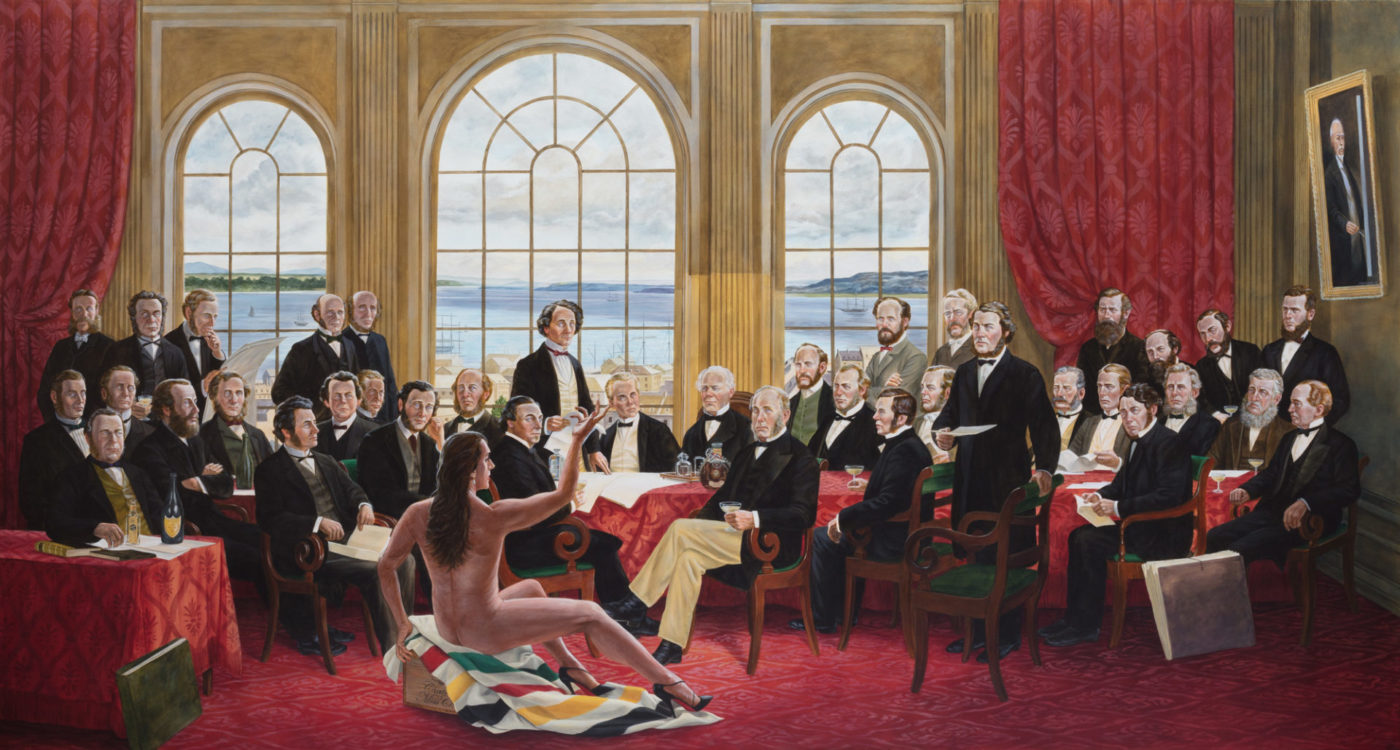Rosanna Deerchild on Shame & Prejudice

Kent Monkman. The Daddies, 2016. Acrylic on canvas. Collection of Christine Armstrong and Irfhan Rawji.
There it is in bright colours – history, our history – laid bare and raw taking up space.
All the space.
Unavoidable.
Powerful.
I went to see Kent Monkman’s Shame and Prejudice: A Story of Resilience exhibition at the Winnipeg Art Gallery with high expectations. I knew about his work, of course, had interviewed him, researched him, seen his art.
But only as small, contained, images on the Internet. Only as snippets of soundbites. Short interviews about a much longer story. A story that has taken 150 years. I was unprepared for what was standing before me. I had read the history. Thought I knew it all. But I had never seen it like this.
The exhibition is presented in nine chapters of Monkman’s time-traveling alter ego Miss Chief Eagle Testickle’s memoirs. Beginning in New France – The Reign of the Beaver, about France and Britain’s obsession with the humble beaver that drove populations to near extinction, to a very cheeky look at The Fathers of Confederation (renamed The Daddies), all the way to Winnipeg’s North End in Urban Res with its chaotic mess of violence and love, beauty, and ugliness, this is not the history you learned in school.
Miss Chief Eagle Testickle delivers subversive satire, sarcasm, and sassy realness while still wearing heels and looking fabulous, darling. Her memoirs are a romp through Canadian landscapes and familiar historical scenes and references.
Monkman takes the old masters of the 19th century North American landscape and European history paintings and twists them into a journey through Canadian ‘herstory’ from a queer Indigenous perspective. And it is unforgettable.
There was one piece that hit me the hardest, the bruise of this memory is still fresh in my mind. This is Chapter V, The Forcible Transfer of Children. The Scream is a deeply disturbing painting of RCMP officers, nuns, and priests ripping children away from distraught parents and taking them off to residential schools. It is a depiction of an era that saw over 150, 000 Indigenous children forced from their families, communities, and cultures. It was a mass genocide.
I stood in front of this 84” x 126” painting that took up the entire wall and I wept. Tears slipped down my face. Immediate. Unapologetic. As I stood in front of this scene that depicts every child ripped from their mother’s arms, I saw my own mother being ripped from hers. Ripping and rippling through every village, every community. There in the faces of this painting was every anguish. Every broken heart. Every excruciating moment. Minute by agonizing minute. Right here in front of me. Children taken from every family until there was nothing. Except the silence. The destruction of this ripping of the family circle was irreparable. We are still surviving through the ripples of residential schools. We see it in the high death rates, incarceration, child apprehension, in every facet of our lives.
I lingered here. Struck silent. Struck by the rawness of my own blood memory. This memory that lives in all of our blood and cried for each of these children. For my mother. For my family. For myself.
It is raw truth, a truth that must come before reconciliation. This exhibit is a question left hanging in the air, unanswered, waiting for Canada to answer.
Rosanna Deerchild is an award-winning author and veteran broadcaster.
4 thoughts on "Rosanna Deerchild on Shame & Prejudice"
Leave a Reply
Related Stories
WAG-Qaumajuq is open Wednesday to Sunday, 11am to 5pm. To plan your visit, check out wag.ca/visit.

Thanks for sharing this heart wrenching response to Monkman’s painting.
I have seen the paintings and agree that they provide essential education on a brutal phase of Canadian story, the many impacts of which are before us everyday.
The Monkman exhibit “Shame and Predujudice” , is a compelling look at our history from a point of view rarely experienced.
Thank you WAG for bringing it to Winnipeg.
Thank you, Rosanna, for your raw personal emotion & your powerful response to the mistressful/masterful work of Kent Monkman. I am a volunteer school programs guide at the gallery. I have seen the exhibit many times, & not enough. I am grateful that you have so eloquently shared your reaction.
A friend said we must recognize Kent Monkman as “Manitoba’s da Vinci” – a changer of our world view.
Your friend is absolutely right, Ellen! This work is so important. Having experienced these massive canvasses the challenge now, for me, is what to do with what I’ve learned. I can’t just walk away from this.